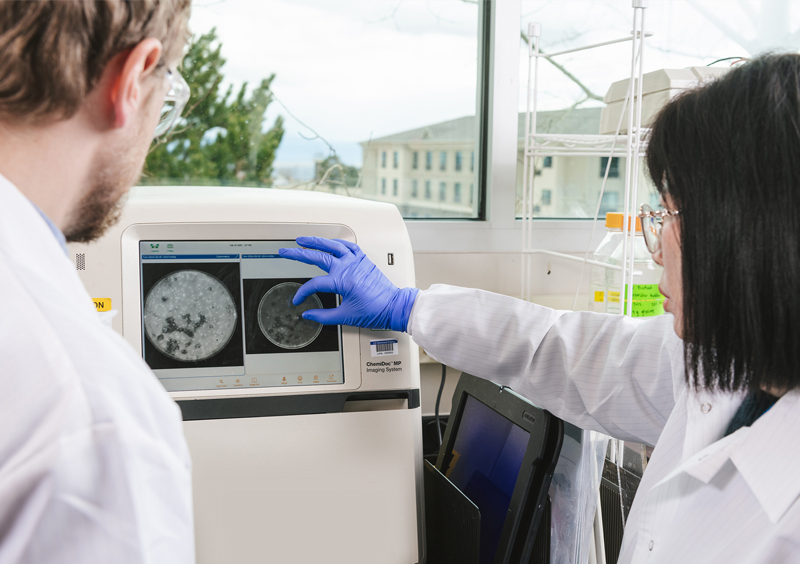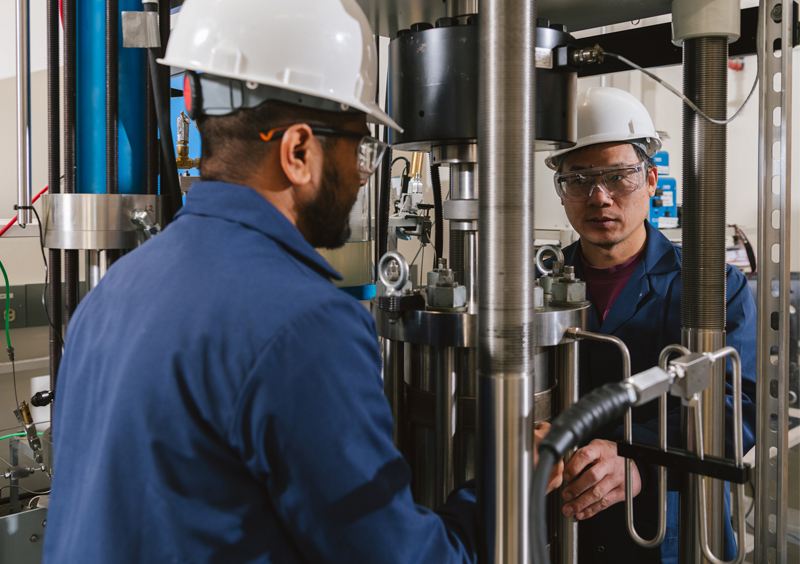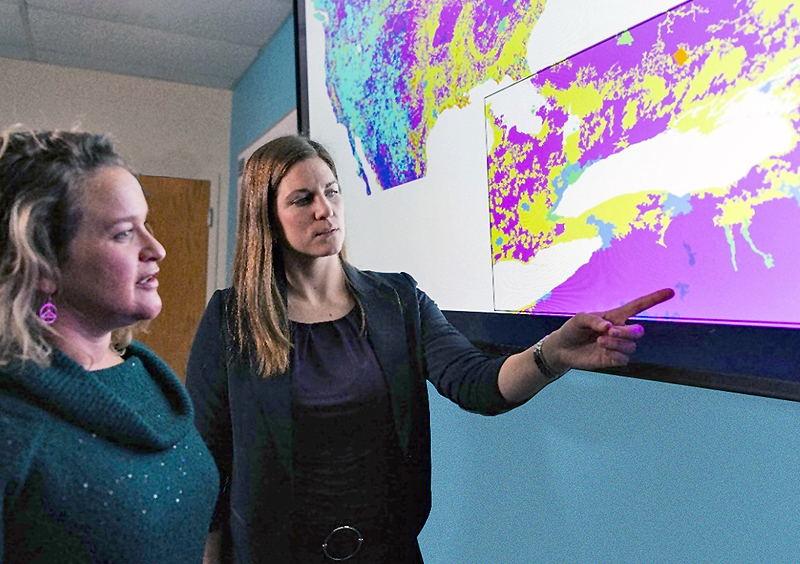Two Los Alamos National Laboratory-led technologies — a software that helps predict disease spread and a screening toolkit that develops enzymes for industrial applications — have won R&D 100 Awards, often called the “Oscars of Innovation.” These two technologies were also awarded special recognition medals along with a third innovation: a software that streamlines geothermal resource prospecting and evaluation. R&D 100 Awards recognize technologies for their ingenuity and potential impact on industries and society as a whole.
“Los Alamos is honored to once again be recognized for driving innovation through these awards,” Laboratory Director Thom Mason said. “A core part of our mission is to transform groundbreaking research into innovations that strengthen industries, expand knowledge and unlock new possibilities across sectors. These awards highlight the remarkable impact of that work.”
Los Alamos 2025 R&D 100 Award winners
The Los Alamos winners are:
- Epidemiological and Earth-System Integrated Model for Vector-Borne Disease Risk Prediction (EpiEarth) — A software that leverages artificial intelligence, big data analysis and process-based models to predict disease spread by mosquitoes, ticks and other vectors.
- Platform to Accelerate Discovery of Tailored Industrial Enzymes (PAD-TIE) — A screening toolkit that engineers improved, efficient enzymes for industrial use.
Special-recognition medal winners from Los Alamos are:
- EpiEarth won the Gold Medal Special Recognition Award for Corporate Social Responsibility.
- PAD-TIE won the Bronze Medal Special Recognition Award for Green Tech.
- Geothermal Design Tool interactive (GeoDTi) — A software that streamlines geothermal resource prospecting and evaluation won the Silver Medal Special Recognition Award for Green Tech.
“Our scientists and engineers are deeply committed to pursuing solutions to the nation’s toughest challenges,” said J. Patrick Fitch, deputy Laboratory director for science, technology and engineering. “This year’s R&D 100 winners demonstrate that commitment and illustrate how bold ideas can become transformative tools that shape industries and improve lives.”
The R&D 100 Awards
R&D 100 Awards honor the latest and best innovations and identify the top technology products of the past year. They span industry, academia and government-sponsored research organizations.
Since 1978, Los Alamos has won more than 200 R&D 100 Awards. The Laboratory’s discoveries, developments, advancements and inventions make the world a better and safer place, bolster national security and enhance national competitiveness.
More information about the winners
This software tool enables the prediction of disease spread by vectors (mosquitoes, ticks, etc.), risk and the impact of mitigation efforts on potential epidemics. EpiEarth provides the detail necessary to give public health decision-makers the tools to respond to an outbreak and the information to understand how a particular intervention strategy will work immediately and over time. The flexible design allows substitution of different models, diseases, hosts or vector species, making the tool generalizable across diseases that affect human, livestock and crop health.
Carrie Manore directed the Los Alamos team of Jeanne Fair, Chonggan Xu, Adam Atchley, Andrew Bartlow, Ryan Crumley, Sara del Valle, Geoff Fairchild, Humberto Godinez Vazquez, Morgan Gorris, Kim Kaufeld, Tammie Lopez, Marina Mancuso, Kaitlyn Martinez, Gul Nair, Nidhi Parikh, Ethan Romero-Severson, Jon Schwenk, Julie Spencer, Xiaming Sun, John Tipton, Amanda Ziemann and former Los Alamos researchers.
Platform to Accelerate Discovery of Tailored Industrial Enzymes (PAD-TIE)
This rapid, low-cost, simple screening toolkit evolves enzymes in a laboratory setting to develop enzymes optimized for industrial applications. The patent-pending technology scans many enzyme variants to discover highly efficient enzymes tailored for industrial use — making industrial processes, such as breaking down plastic to its building block molecules, more efficient and economical.
Hau Nguyen led the Los Alamos team of Thomas Groseclose and Taraka Dale.

Geothermal Design Tool interactive (GeoDTi)
This commercially copyrighted software provides a one-stop shop for geothermal energy prospecting and design optimization by incorporating physical and economic inputs to help stakeholders and decision-makers optimize geothermal energy. GeoDTi incorporates the physics of faults and fractures to answer critical questions about the relative performance of different locations, well layouts and flow rates to assure a maximum return on investment. Corporations, universities and national labs already use GeoDTi to evaluate geothermal energy development.
Luke Frash led the Los Alamos team of Bulbul Ahmmed and Bijay KC.

Four additional Los Alamos technologies were recognized as finalists for R&D 100 Awards:
LAROMance (Los Alamos Reduced Order Models for Advanced Nonlinear Constitutive Equations) — This software predicts complex material behavior of components and advanced material in large-scale, safety-critical scenarios.
The commercially copyrighted software supports informed decision-making for safety-critical applications such as nuclear energy and aerospace. The code provides a turnkey solution to model material response at the component level during harsh or off-normal scenarios that are difficult to study experimentally. LAROMance bridges the gap between microstructure-level physics and large-scale engineering applications and provides a powerful tool for safety assessments and material performance optimization under extreme conditions.
Laurent Capolungo led the Los Alamos team of Ricardo Lebensohn, Andre Ruybalid, Andrea Rovinelli and Aaron Tallman. The team also included collaborators from Idaho National Laboratory.
Object-based Computational Storage System (OCSS) — This technology revolutionizes data processing by bringing computation to storage.
Modern supercomputers are challenged by moving massive datasets for analysis. OCSS provides a fully integrated, end-to-end solution that processes and retrieves only the portions of data needed. This development minimizes data transfers, reduces post-processing, and ensures efficiency. OCSS enhances computational performance across AI, scientific and commercial applications, providing unmatched speed and efficiency as organizations navigate big data.
Los Alamos led the joint nomination with SK hynix. Qing Zheng directed the Los Alamos team of Jason Lee, David Bonnie, Gary Grider and Dominic Manno.
Spacecraft Speedometer — This instrument improves space traffic management and reduces the risk of collisions.
The growing number of satellites and amount of debris in low Earth orbit increase the threat of collisions among commercial and national security spacecraft. The patent-pending Spacecraft Speedometer provides critical satellite speed data when GPS or ground station tracking fail during severe space weather. Its compact size, weight and power requirements allow for deployment on spacecraft supporting a variety of missions. The U.S. Air Force Academy has implemented it for the Department of Defense Space Test Program, where it has made accurate speed measurements and space weather observations on the International Space Station.
Los Alamos led the R&D 100 nomination with collaborators from the United States Air Force Academy. Carlos Maldonado directed the Los Alamos team of Gabriel Wilson, Philip Fernandes, Kelly Moran, Ky Potter, Rachel Ulrich, Lauren Castro, Brian Weaver and Matthew Dunn.
Vibration Intelligence System for Industrial Operations and Networks (VISION) — This sensor uses machine learning to provide facility-level optimization and cybersecurity monitoring.
The nonintrusive wireless vibration sensor checks the operating conditions of most types of industrial machines, allowing large facilities to monitor most types of machinery for cost reductions in energy consumption, maintenance and downtime. By tracking machinery operations independent of industrial control systems and the internet, it provides a layered cybersecurity measure against cyberattacks.
Neil Loychik led the Los Alamos team of Martin Ward and Michael Sekenski.
LA-UR-25-29084






